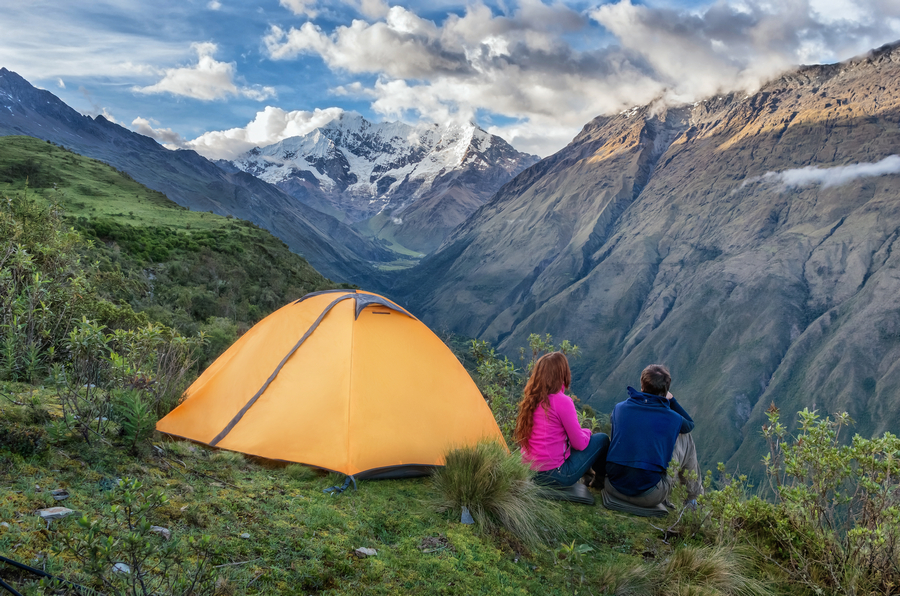

Claire Dean
Travel in South America is a joy to behold. The rich variety of destinations, experiences, landscapes and geography fascinated me so much, that I chose to relocate here, over 20 years ago! The best thing I ever did! Allow me to share my knowledge and passion for Central and South America with you and help you plan your holiday of a lifetime!

Hacks for hikes
Written by:Claire Dean
Last Update: 2025-02-12
Trekking in the Andes can be challenging! You have the climate, the altitude the remote conditions and the Andes themselves to deal with! Most of the best and spectacular places to visit are at the end of a dusty or muddy road- depending on the season. Here are some backpacking hacks to help make things run smoother on your trek in the Andes.

Trekkers in the Salkantay trek
1. Altitude
Altitude plays a big part when trekking in the Andes. Air is thinner, oxygen is less and your stomach seems to do its own thing at elevation! ALWAYS acclimatize appropriately. The longer you can acclimatize the better and usually a 3 day acclimatization is enough unless you plan to go to higher than 5000 m elevation. Each human organism reacts differently at altitude and some people acclimatize quicker than others. Some people suffer terribly and others have no issues. Fitness levels also do not have any positive impact on acclimatisation; however, things like smoking, unhealthy eating, low water intake will certainly have a negative on how you acclimatize. Coca tea is a must when trekking in The Andes and will be served in abundance on most treks in the Andes, especially in Peru and Bolivia.
2. Fitness
Fitness in the form of cardiovascular exercise is always a great preparation for trekking in The Andes. There basically is no “flat” in the Andes. What they locally call “Inca flat” is definitely up and down. The Andes by nature are composed of ascents and descents, this combined with altitude, make hiking that bit more challenging. If you are used to exercise, you will have an easier time on the trek; however, if you are a super fit athlete, it is sometimes more difficult to acclimatize as your heart rate is naturally lower and acclimatization needs your heart to speed up a little during acclimatization. Spinning, running, aerobic exercise will help you to acclimatize quicker and have a better experience on the trek.
3. Weather
Weather in the Andes is unpredictable. It can rain, snow, be sunny with gale-force winds, all at the same time! Be prepared for all types of weather conditions as the weather can change with no notice whatsoever. The sun is also vicious in the Andes and even when it is not sunny and is totally overcast, it will burn, so use sunblock at all times.
4. Pack Lightly
Another one of our backpacking tips and tricks is to pack lightly. While you may be used to carrying a fair amount of weight, trekking at altitude with weight on your back will slow you down and will tire you more. Usually, a trek in the Andes will include mules (not the Inca Trail, though) and you will be given a duffle bag for your heavier items which will be carried by the mules. Keep your essential items for that days’ trekking such as sunblock, waterproof jacket, water, camera and snacks, toilet paper and a torch, sunhat. The rest pack away in the duffle :)

Mules to the rescue!
5. Extra battery chargers
Batteries and phones lose their charge much quicker at altitude. Make sure you have extra battery chargers so that that you can take the photos you need, charge your cell phone and cameras etc. A lot of treks do not have cell phone reception, so always put your phone in flight mode if you are out of range, to avoid the battery running down.
6. Duct tape
Duct tape is a traveller's best friend. It can fix holes in tents, shoes, waterproof jackets, bottles, in fact, everything! Wrap it around your water bottle to save on space! Duct tape is also, believe it or not, perfect for blisters! At the first sign of a blister cover it with duct tape and it will protect and pad the blister so that that it doesn't get any bigger!
7. Plastic and Ziploc bags
The only time I will recommend anything plastic on a trek is to pack your clothes. Weather conditions are unpredictable and there is nothing worse than getting to camp and all your clean clothes are soaked! Pack in a variety of plastic bags to protect from wet weather. Also, Ziploc bags can protect against bottles exploding, phones or electrical items getting wet, foodstuffs keeping fresh.
8. Trekking poles
Even if you do not usually use walking sticks,….use them! Especially on the downhill sections, walking sticks help the knees and you can keep the weight of them down those steep Inca steps. They also aid with balancing un rugged terrain. If you use the fold-up sticks, then you can always pack them away when not in use. Today there are excellent, lightweight brands so they will not add to the weight you have to carry.

Trekking poles are basic to support knees during the trek
9. Always know where south is
Even if you do not trek with a compass, you can always tell where south is. Using your watch, point the hour finger at the sun, then find the midpoint between the hour hand and 12 o'clock, this is South!
10. Hot water bottles
Camping in the Andes is generally cold at night. Temperatures can get below 30°c in winter (Yes -30°c!). To keep an extra bit of warmth in your sleeping bag….. boil your drinking water the night before and fill your water bottles, while the water is still hot and put it in your bag! It will be cold enough for drinking the following day and of course, will be purified!
11. Headlamps
Always take a headlamp, they are generally less bulky than a torch, occupy less space and also keep your hands free! Great when managing Andean bathrooms in the countryside!
12. Toilet Paper
ALWAYS take more than you think you will need, you will generally run out! Runny noses and other parts of the anatomy will always be happy to have some extra loo roll!

Enjoying the scenery with some camping comforts.
13. First Aid kit
You will be trekking and camping in remote areas. Take Band-Aids, sunscreen, antiseptic cream, baby wipes, tummy tablets aspirin or paracetamol and any personal medication you may need. That should do it! Anything else is just extra weight!
14. Decent fitting hiking boots
Make sure your boots are worn in, never trek in brand new boots, they WILL give you blisters! It is usually best to buy a half size bigger than your usual size as you generally will use thicker socks. Always take extra socks! Feet will generally get wet either by sweat, rain rivers or unexpected puddles.
15. Take extra layers
Thin cotton layers are the best. You will sweat during the trek so a change of shirt when you get to camp will mean you won't catch a chill and you won't smell so much the next morning! Zip-off trousers to shorts are great for trekking. Leggings or tights/stockings are great for extra layers on the legs.
16. Take sandals/flip flops
Let your feet breath at the campsite. They will appreciate it as will your tent companion! Sandals are great if you go to hot springs if you are at camp or need an urgent bathroom trip in the middle of the night!





